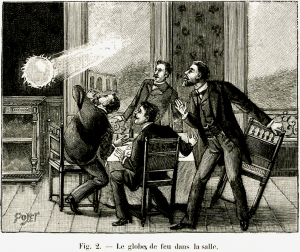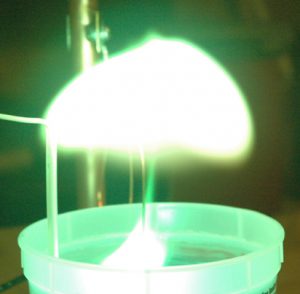Sometimes they come and go with a bang, sometimes they are silent. They glow bright as a lightning in white, yellow, red or blue. They fly freely through the room and some of them even permeate solid matter. They all have in common that they appear mostly during stormy weather, are somewhat spherically shaped and have a lifetime of several seconds.[1] For many centuries people report about observations of lightning balls as depicted in figure 1.
Clearly, ball lightnings cannot be the same phenomenon as a strong electric discharge like a bolt lightning since their effect is not as dramatic. A full scientific explanation is not yet found. Do they really exist or are they only the product of frightened people’s minds?Sure, bolts can cause phosphenes, impressions in the focus of the eye that remain some moments after looking into bright lights.[3] But during the last years scientist came up with some experiments that deliver plausible explanations of their formation:
Abrahamson and J. Dinniss found out that after the impact of a bolt into the soil a cloud of Silicon (Si), Silicon carbide (SiC) and Silicon monoxide (SiO) nanoparticles evaporates and oxidizes in a timespan of several seconds. During this time the energy is released as a bright ball-shaped light.[4]
At the IPP in Garching, Germany, Prof. Dr. Gerd Fu?mann vaporized and ionized a tiny amount of water by an electrical discharge between two electrodes above a water surface. The glowing plasma cloud, called plasmoid, has a spherical or mushroom-like shape (shown in figure 2) and a lifetime below one second.[5] The appearance of these plasmoids is demonstrated in a short video on their web page: http://www.ipp.mpg.de/2977926/kugelblitze
Still these experiments lack to explain all the observed properties of a ball lightning: the free movement, the ability to permeate matter and the long lifetime of several seconds. It is plausible that there might occur spherical light phenomena during bolt impacts. An explanation of the rather vivid properties of a ball lightning is yet to come. But maybe they belong to the section of narrative decor.– Tatjana Daenzer
Read more:
[1] Smirnov, B. M., Phys. Rep. 1987, 152, 177-226.
[2] https://upload.wikimedia.org/wikipedia/commons/9/97/Ball_lightning.png
[3] Peer, J., Kendl, A., Physics Letters A, 2010, 374, 4797-4799.
[4] Abrahamson, J., Dinniss, J., Nature, 2000, 403, 519-521.
[5] Fussmann, G., Phys. Unserer Zeit. 2008, 5, 246-252.

